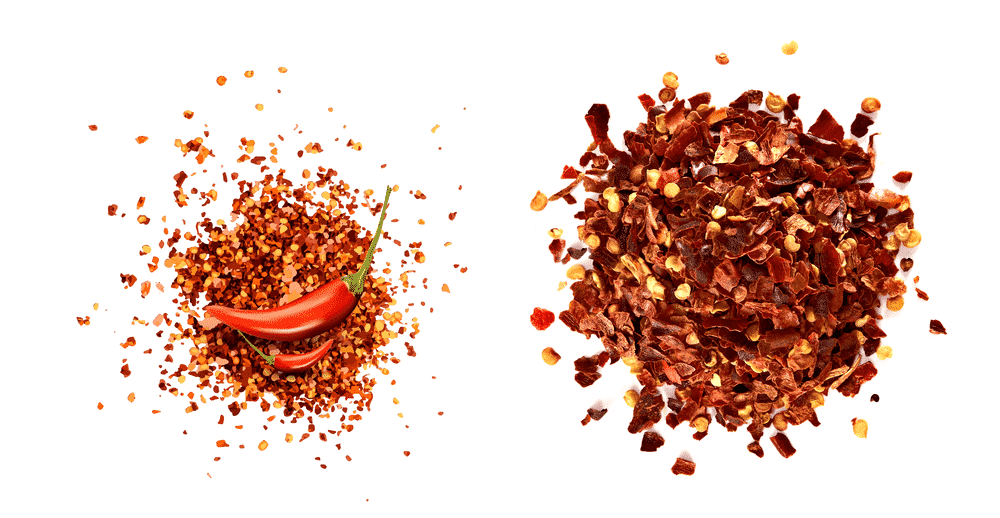
In every kitchen, there are glass jars filled with red peppers and red pepper flakes. The red peppers can be used in various recipes, and we wouldn’t mind saying that everyone uses them. That’s to say because red pepper can be used for chicken as well as vegetables.
However, there are different types of red peppers which is why we are talking about crushed red pepper vs. red pepper flakes. So, let’s check out the details about different types of red pepper!
Crushed Red Pepper vs Red Pepper Flakes
Crushed Red Pepper
The crushed red pepper is known to be a spice or condiment which includes crushed red chili peppers as well as dried red chili peppers. Crushed red pepper is generally made from cayenne peppers, but the commercial ones are also made with a variety of cultivars. In the case of hotness level, it ranges from 30,000 SHU to 50,000 SHU.
Crushed red peppers originate from Bukoyo because it was made for the first time there. The crushed red pepper is widely used in Mediterranean restaurants. In particular, it is generally used in pizza parlors. Crushed red pepper has a higher seeds ratio (these seeds have the highest spice ratio, by the way). Crushed red pepper is used in sausages, soups, chowders, pizza sauces, and spaghetti sauce.
In some cases, people also use them for pickling the blends. In Turkey, crushed red pepper is used and served as a condiment with a lesser seed count. However, it’s known as Biber in the English language. For the most part, it’s made from one type of pepper, which impacts the quality and taste of the spice. Crushed red pepper generally has a red color because the seeds are removed before the chilis are crushed.
In addition, crushed red pepper is sealed and packaged after removing the seeds. The color ranges from light red to piping red color. It wouldn’t be wrong to say that the color of crushed red pepper will depend on the type of chili used. There is heat and spiciness with crushed red pepper, but it’s pretty much mild. In some cases, you will also feel sweet undertones and mellow flavor.
For the most part, crushed red pepper is suitable for beginners who want to shift to spicy food without upsetting the digestive system. The best thing about crushed red pepper is that its spiciness is just perfect for adding a kick to salad dressing and other marinades. Also, it can be added to sauces and other savory recipes.
Red Pepper Flakes
The red pepper flakes are made with a mix of different peppers (peppers only from capsicum annum are used for making red pepper flakes). In particular, fresno, jalapeno, Anaheim, and bell peppers are used for making red pepper flakes. In the majority of cases, red pepper flakes are made with cayenne pepper. All in all, they are a combination of different peppers, but cayenne pepper takes the major part.
Red pepper flakes will have a one-dimensional flavor, and it is widely used for achieving the heat and spiciness. It doesn’t matter which peppers are used for making red pepper flakes; all of them are spicy. Red pepper flakes are a combination of red pepper flesh (dried form) and light-colored seeds. However, the seed will add higher heat and spiciness to the recipes.
Different peppers are dried and pulverized to make red pepper flakes (the ones we see in the glass jars). For the most part, they are dried in the industrial ovens for making red pepper flakes that lead to efficient and time-effective development. The best thing about red pepper flakes is that they are ready for rumbling and are extremely spicy and reasonably priced.
When it comes down to pulverization, the peppers are dried and pulverized with seeds. Truth be told, they have a complex flavor since the entire family of peppers is used for making it. The red pepper flakes have white and red hues (the colors are all mixed up). These red pepper flakes can retain the seeds once the drying process is completed.
As far as the flavor is concerned, it ranges from hot to the hottest. To illustrate, red pepper flakes have an intense flavor since seeds are present (more seeds will lead to higher spiciness, and vice versa). These flakes can be used as pasta and pizza topping. Last but not least, it can be used for making glazes and dips for buffalo chicken and chicken BBQ.